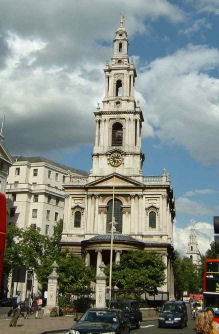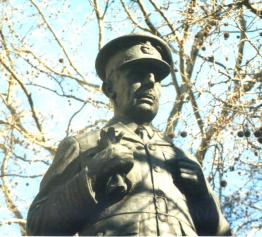

A Spring Day in London Town
By Jennifer Ball
This article was originally published in the December 2006 edition of Soul Search, the journal of The Sole Society
I was born in the East End of London and spent the first few years of my life literally within a stone's throw of my Sole Grandparents flat in Wapping High Street.
Hitler's Luftwaffe was responsible for my change of address but because I am a Londoner it is to the capital that I return when my batteries need recharging. So it was then that a morning in April saw me crossing the busy Aldwych, walking down through India Place past where D.C. Jim Morrison was gunned down in 1991 and finally making the busy traffic island in the Strand that houses the two churches of St. Mary Le Strand and St. Clement Danes.
 The
latter was really my aim but I can never resist popping into the Georgian gem
that is St. Mary Le Strand. The original mediaeval parish church was pulled down
in 1549 on the orders of the Duke of Somerset who then incorporated the stones,
together with many more, into his new palace across the road. The Duke himself
met his end, not for vandalism but treason, at the Tower some three years later.
The
latter was really my aim but I can never resist popping into the Georgian gem
that is St. Mary Le Strand. The original mediaeval parish church was pulled down
in 1549 on the orders of the Duke of Somerset who then incorporated the stones,
together with many more, into his new palace across the road. The Duke himself
met his end, not for vandalism but treason, at the Tower some three years later.
The parishioners were left without a church for nearly two hundred years. They worshipped at the Savoy Chapel, elected their own minister and kept separate parish records of births, marriages and deaths but always remembered that they had lost their own church. When in 1710 it was proposed to build fifty new churches they were quick to ask for one. The Commissioners saw the advantage of a prominent site in the middle of the Strand for the first of these new churches and James Gibbs, who had studied in Rome, was appointed as architect. The building was finally consecrated on 1st January 1724. James Gibbs went on to design St. Martin's in the Fields.
If you visit St. Mary Le Strand today, you will enter the railings by way of the Iron Gate, surmounted by its lantern and stand in the small stone flagged courtyard beyond. The morning I visited it was scattered with pink petals from the magnolia tree and deeper pink ones from the tulips growing in the border. The outer oak doors stand open so from here you can see through the modern glass ones to the deep blue of the windows above the altar. These were inserted to replace those damaged during the war and strangely enough this was the only damage that this little church sustained. Once inside you will notice that the side windows are high up in the walls which help to shut out the noise of the traffic which was a problem even in the 1700's.
The Hanoverian arms are set in the pediment of the triumphal arch which stands at the entrance to the sanctuary. The three Hebrew letters on the ceiling here compose the name Jehovah and the triangle enclosing them symbolises the three persons of the Trinity. The bunches of grapes and ears of corn are to remind us of the Eucharist. The pulpit is thought to be by Grinling Gibbons. If so the master, who was buried with his wife just round the comer in the crypt of St. Paul's Covent Garden, must have sat and admired his own work. The wood is a beautiful colour and the finished pulpit so full of movement that it reminds me of a billowing wave.
On my way back into the sunshine that morning I spoke to one of the ladies in attendance who mentioned that the parents of Charles Dickens were married in St. Mary Le Strand. It seemed odd that there was no reference to this interesting connection in the church notes, nor indeed in any books I consulted so I checked it out in the Parish Registers held, along with all the others for the City of Westminster, at the Westminster Archives in St. Ann's Street. Sure enough there was the entry for the 13th June 1809. John Dickens Bachelor of this Parish to Elizabeth Barrow also of the Parish.
 When
I finally walked the short distance to St Clement Danes I was lucky enough to
hear the tune of Oranges and Lemons being played above the roar of the traffic.
As usual there were the television cameras pointing at the Law Courts opposite
but I took the opportunity to take a closer look at the statues of Lord Dowding,
Commander in Chief of Fighter Command from 1936 to 1940 and of Marshall of the
Royal Air Force Sir Arthur Harris 1942 to 1945. The inscription on the latter
mentions the 55,000 men of Bomber Command who died in the conflict of the Second
World War. It is fitting that the statues of the two men were placed here
because St. Clement Danes became the Central Church of the Royal Air Force in
1957.
When
I finally walked the short distance to St Clement Danes I was lucky enough to
hear the tune of Oranges and Lemons being played above the roar of the traffic.
As usual there were the television cameras pointing at the Law Courts opposite
but I took the opportunity to take a closer look at the statues of Lord Dowding,
Commander in Chief of Fighter Command from 1936 to 1940 and of Marshall of the
Royal Air Force Sir Arthur Harris 1942 to 1945. The inscription on the latter
mentions the 55,000 men of Bomber Command who died in the conflict of the Second
World War. It is fitting that the statues of the two men were placed here
because St. Clement Danes became the Central Church of the Royal Air Force in
1957.
The Wren church of 1682 was destroyed, like much else in London, in the air raid on the night of the 10th May 1941. Only the walls and tower were left standing but worldwide contributions ensured its restoration. Inside the church is light and airy due to the windows of clear Reamy Antique glass which create patterns of light and shade probably as Wren himself must have wished. A curving gallery runs around both sides in the centre of which, facing the altar, is the magnificent organ which was a gift from the American Air Force. In the vaulted ceiling is the Stuart coat of arms. The pulpit is said again to be the work of Grinling Gibbons and below this is the chair given by Douglas Bader in memory of his first wife while across the aisle you can see the McIndoe seat given in his memory by the Guinea Pig Club. (Note the flying pig crest!)
 Should
you visit St. Clement Danes do make time to pop down to the crypt where there is
much to see that relates to present times with gifts from the Royal Norwegian
Air Force, the Belgian Air Force and the Royal Netherlands Air Force but stark
in its simplicity this large area was once stuffed full of coffins and the
plates from some of these can be seen on the walls.
Should
you visit St. Clement Danes do make time to pop down to the crypt where there is
much to see that relates to present times with gifts from the Royal Norwegian
Air Force, the Belgian Air Force and the Royal Netherlands Air Force but stark
in its simplicity this large area was once stuffed full of coffins and the
plates from some of these can be seen on the walls.
The wife of the poet John Donne was buried here at St. Clement Danes and we can read the inscription he wrote promising to join his ashes with hers "in a new marriage under God." When he died in 1631 as Dean of St Paulís he asked to be buried in the Cathedral. The churchyard was closed, like so many others in London in 1852.
There is so much to see in the church but I must mention the nearly 800 unit and squadron badges sculpted in Welsh slate that are embedded in the floor and the Book of Remembrance recording the names of American Servicemen of the Eight and Ninth Air Forces killed while serving in the U.K. during World War Two. However it is the British memorial books that I have come to see in particular. There are ten altogether which record all the names of R.A.F. personnel killed between 1911 to the present day. The last one is updated every six months. Each book has a facsimile for the use of visitors and the entries are in name order.
I suppose technically there were no R.A.F. personnel before 1st April 1918 but these records obviously include members of the Royal Flying Corps. Those names listed below are the ones that we as a society research and come from 1911 to the end of the second World War. Mostly they will all be listed on the Commonwealth War Graves Site.
* = 1st book.
Edward Laurence Saul
Edwin Kerrison Saul
Leslie Albert Saul
Norman Priestly Saul
Thomas Saul
Victor William Saul
William Saul
William Allan Sewell*
Christopher Gordon Sewell
Donald Alan Sewell
Francis Sylvester Sewell
George Aiden Sewell
Gerald Walter Sewell-de-Gency
Horace Arthur William Sewell
Horace Basil Sewell
John Kenneth Sewell
Kenneth George Sewell
Kenneth Randolph Sewell
Malcolm Charles Sewell
Norman Frederick Sewell
Peter Redman Sewell
Vernon Young Hodgson Sewell
William Arthur Sewell
William Richard Percival Sewell
William Stuart Sewell
Donald Enright Soles
George Sole
John Walter Sole
Walter Sole
Arthur Norbury Solly*
Charles John Solly
Fred Thomas Solly
Frederick Albert Solly